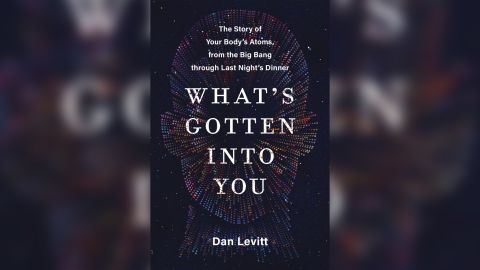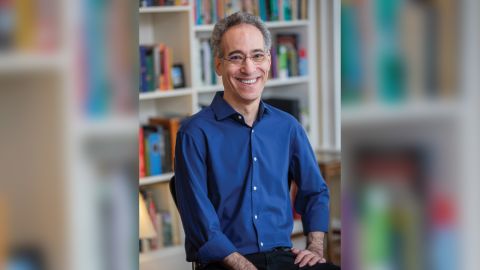Sign up for CNN’s Wonder Theory science newsletter. Explore the universe with news on fascinating discoveries, scientific advancements and more.
CNN
—
In its violent early years, Earth was a molten hellscape that ejected the moon after a fiery collision with another protoplanet, scientists now suspect. Later, it morphed from a watery expanse to a giant snowball that nearly snuffed out all existing life.
Then hyper-hurricanes with waves as high as 300 feet pummeled the newly thawed ocean. But that’s nothing compared with the celestial turmoil and fireworks in the 9 billion years before the birth of our planet.

Science and history documentarian Dan Levitt’s upcoming book, “What’s Gotten Into You: The Story of Your Body’s Atoms, From the Big Bang Through Last Night’s Dinner,” evokes a series of striking and often forceful images in tracing how our cells, elements, atoms and subatomic particles all found their way to our brains and bones and bodies. The book comes out on January 24.
“Now we know that the origin of the universe, the making of elements in stars, the creation of the solar system and Earth and the early history of our planet was incredibly tumultuous,” Levitt told CNN.
The nearly incomprehensible explosions, collisions and temperatures, though, were essential for life.

A disturbance in Jupiter’s orbit, for example, may have sent a hail of asteroids to Earth, seeding the planet with water in the process. And the molten iron forming Earth’s core has created a magnetic field that protects us from cosmic rays.
“So many things happened that could’ve gone another way,” Levitt said, “in which case we wouldn’t be here.”
Reconstructing the epic step-by-step journey of our atoms across billions of years, he said, has filled him with awe and gratitude.
“Sometimes when I look at people, I think, ‘Wow, you are such incredible organisms and our atoms all share the same deep history that goes back to the big bang,’ ” he said. He hopes that readers will recognize “that even the simplest cell is incredibly complex and worthy of great respect. And all people are, too.”
A stellar mystery
Our bodies contain 60 or so elements, including the torrent of hydrogen unleashed after the big bang and the calcium forged by dying stars known as red giants. As Levitt assembled the evidence for how they and more complex organic molecules made their way to us, he weaved in the tumultuous history of the scientific process itself.
He didn’t initially set out to parallel the turbulence in the universe with upheavals in the scientific world, but it definitely came with the territory. “So many scientific certainties have been overthrown since our great-grandparents were alive,” he said. “That’s part of the fun of the book.”
After Levitt finished his first draft, he realized to his surprise that part of the scientific turmoil was due to various kinds of recurring bias. “I wanted to get into the heads of scientists who made great discoveries — to see their advances as they did and understand how they were received at the time,” he said. “I was surprised that almost every time, the initial reaction to groundbreaking theories was skepticism and dismissal.”
Throughout the book, he pointed out six recurring mental traps that have blinded even brilliant minds, such as the view that it’s “too weird to be true” or that “if our current tools haven’t detected it, it doesn’t exist.”
Albert Einstein initially hated the strange idea of an expanding universe, for example, and had to be persuaded over time by Georges Lemaître, a little known but persistent Belgian priest and cosmologist. Stanley Miller, the “father of prebiotic chemistry” who ingeniously simulated early-Earth conditions in glass flasks, was a notoriously fierce opponent of the hypothesis that life could have evolved in the deep ocean, fueled by mineral-rich enzymes and super-heated vents. And so on.
“The history of science is littered with elder statesmen’s grand pronouncements of certainties that would soon be overturned,” Levitt writes in his book. Thankfully for us, the history of science is also full of radicals and freethinkers who delighted in poking holes in those pronouncements.
Constructive destruction
Levitt described how many of the leaps forward came about by researchers who never received due credit for their contributions. “I’m drawn to unsung heroes with dramatic stories that people haven’t heard before,” he said. “So, I was pleased that many of the most gripping stories in the book turned out to be about people who I hadn’t known about.”
They are scientists such as Austrian researcher Marietta Blau, who helped physicists see some of the first signs of subatomic particles; Dutch physician and philosopher Jan Ingenhousz, who discovered that sunlit leaves can create oxygen via photosynthesis; and chemist Rosalind Franklin, who was instrumental in working out the three-dimensional structure of DNA.
Wonders of the universe
The lightning spark of new ideas often struck independently around the world. To his surprise, Levitt found that multiple scientists worked out plausible scenarios for how life’s building blocks could have begun assembling.
“Our universe is awash in organic molecules — many of them are precursors to the molecules that we’re made of,” he said. “So I alternate between thinking that it’s just so improbable that creatures like us exist, and thinking that life must exist in many places in the universe.”
Nothing about our own journey from the big bang has been straightforward, though.
“If you try to envision how life evolved from the first organic molecules, it had to have been a herky-jerky process, full of twisted pathways and failures,” Levitt said. “Most of them must have gone nowhere. But evolution has a way of creating winners from countless experiments over long periods of time.”
Nature also has a way of recycling the building blocks to create new life. A nuclear physicist named Paul Aebersold found that “we swap out half of our carbon atoms every one to two months, and we replace a full 98 percent of all our atoms every year,” Levitt writes.
Like a house constantly under renovation, we are ever-changing and replacing old parts with new ones: our water, proteins and even cells, most of which we apparently replace every decade.
Eventually, our own cells will grow quiet, but their parts will reassemble into other forms of life. “Although we may die, our atoms don’t,” Levitt writes. “They revolve through life, soil, oceans, and sky in a chemical merry-go-round.”
Just like the death of stars, in other words, our own destruction opens up another remarkable world of possibility.
Bryn Nelson is an award-winning science writer and author of the book “Flush: The Remarkable Science of an Unlikely Treasure.” He lives in Seattle.
